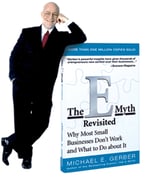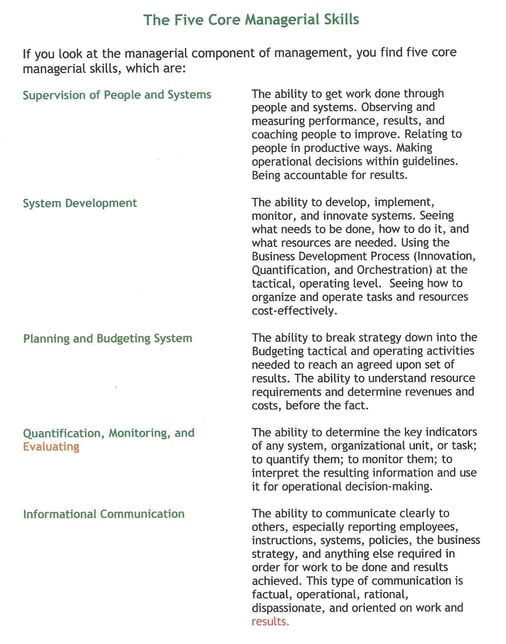As an E-Myth Senior Business Coach for ten years I used the E-Myth resources and tools to help my small business customers apply the systems concept to build their business.
 hen it comes to leadership and management, particularly leadership, Michael Gerber (author of the E-Myth Revisited: Why Most Small Businesses Don’t Work and What to Do About It) offered 3 critical characteristics for leadership. He noted these as requirements for building a business more important than systems. Without the first of these characteristics Gerber said there’s no reason to have systems at all in a business.
hen it comes to leadership and management, particularly leadership, Michael Gerber (author of the E-Myth Revisited: Why Most Small Businesses Don’t Work and What to Do About It) offered 3 critical characteristics for leadership. He noted these as requirements for building a business more important than systems. Without the first of these characteristics Gerber said there’s no reason to have systems at all in a business.
What are the three critical aspects of leadership? Here’s what Michael Gerber suggested:
- VISION
- REMBEMBERING
- TENACITY
Today’s blog is about the difference between a leader and a manager. I feel it’s important to share with you the nature of what Gerber feels are critical aspects of leadership. They harmonize with top thought leaders like Jim Collins, Patrick Lencioni, Simon Sinek and of course Verne Harnish.
VISION: If you read Happiness is a Direction you know the value of vision. Perhaps you didn’t need to read this blog to understand it. Vision is about the direction the business is moving toward. From our Strategic Discipline and Gazelles fundamentals it includes elements like Core Values, Core Purpose, 3-5 Year Plan, Annual and Quarterly Plans, and BHAG. If done correctly it should include a Strategy Statement. It’s about clarity and the place to harness this is in your One Page Strategic Plan. Yet how many times is this simply forgotten, not just by the company, but by the leadership team and even the CEO or owner. That’s why the next aspect is so important.
REMEMBERING: It’s easy to get lost in the day to day operations of your business. Everyone does from time to time. This aspect is an absolute requirement of leadership. Dudley Fleck, Fleck Sales, one of my customers is a master and making sure his team keeps their visionary elements clear and repeating throughout Fleck Sales. Every meeting with leadership team starts with a review of Fleck Sales Core Values, Core Purpose, Vision and Strategy Statement. This habit is cascaded into the meeting rhythms of their leadership team’s weekly meetings. Remembering provides clarity. It’s often said that the minute you start getting sick of reminding your people of these elements is the minute that they are just beginning to get it.
TENACTY: Another way to view this is the word commitment. How strong is your tenacity to keep the vision in front of your people? Always there will be resistance. Not just from your organization, but inside you. You need to fight the urge to believe the team has heard it enough. Never! You cannot repeat your vision too much. Gerber notes that when Bill Gates had a vision to have a computer on every desk, he was met every day with stern resistance. Not just from his internal staff, but the competition. How committed are you to your vision? Do you understand and include resistance as part of the realization of accomplishing your vision? If you’ve not recognized nor included the battle, the defiance you will run into on the way to achieving your vision, don’t expect to attain it.
Leadership and Management: What's the Difference?
Leadership and management are both concerned with achieving results. Leadership determines the shape of things to come, what results are needed on the way to that future, and the path that will be taken to get it all done. Management is concerned with doing it.
Management is getting results through people and systems. Systems run the business; people run the systems, and managers "run" the people.
Leadership is vision, action, spirit - seeing what needs to be done, knowing how to do it, and influencing others to do it. Leadership - effective leadership - determines the results to be accomplished (the vision), creates the strategies for accomplishing them (the actions), and inspires people to accomplish the vision through the strategies (the spirit).
Being a manager doesn't automatically make you a leader. The best managers are good leaders, but many managers - possibly most managers - aren't very good leaders.
What's the difference? The difference lies in the differences in the abilities of managers. There are two kinds of abilities, or skills, that managers display - leadership skills and managerial skills.
Five Core Leadership Skills
In E-Myth Module 15, Essential Leadership Skills the E-Myth identified the following as Five Core Leadership Skills. See if you can identify with these.
 Five Core Managerial Skills
Five Core Managerial Skills
In the same module they looked at the managerial components of management. See in the chart the Five Core Managerial Skills.
 Finding the Balance
Finding the Balance
It's easy to see and your own experience surely confirms that some people are stronger in leadership skills, some in managerial skills. Many are weak in both areas, and very few are strong in both. You probably have some ideas about your own leadership and managerial strengths and weaknesses.
Balance is important for your business. The business needs a balance of leadership and managerial skills - so much the better if you and each of your managers is also individually balanced.
Why is balance important? Because (you've heard this before) your business is an integrated organism. If you have too little leadership, or too little managerial skill in the business, or if one "overpowers" the other, the business itself gets out of balance.
It's much clearer if you think of the behavior of your managers and how they need both leadership and managerial skills to do their jobs in the most effective way. For instance look at four areas of focus for managers: decision making, communicating, the time span of their attention, and their thinking habits.
Decision-making The decision making of a "pure" leader is free form, unconstrained by rules and the past. The leader creates the questions and alternatives, and makes decisions by criteria appropriate to each decision. A "pure" manager makes rule-based decisions that follow strict, explicit criteria and processes. A business needs the ability to make decisions both ways.
Communicating Leadership skills tend to result in inspirational ways of communicating, painting a clear picture of the future, generating commitment and energy, and motivating others to strive to achieve the vision. Managerial skills tend to result in informational communications that emphasize clarity, accuracy, detail, and commitment to achieving results in the present. A business needs both kinds of communication.
Time span of attention Leadership skills tend to be future oriented, with a firm grasp on the present as the foundation and the "jumping off point" for the future. Managerial skills tend to be oriented on the present, with a strong awareness of experiences and precedents grounded in the past. A business needs both views.
Thinking habits You can never know what goes on inside someone else's mind, but behavior and language give us hints. Generally (with many exceptions) leadership thinking seems to be more intuitive, holistic, integrated, "big picture," and "out of the box." Managerial thinking patterns seem to be more linear, logical, analytical, and detailed. They can both be focused, creative, strategic, proactive, and pragmatic, but there's a more free- form pattern to leadership thinking and a more process-based pattern to managerial thinking. And businesses need both ways of thinking.
Managers or Leaders?
It's possible for someone to be a manager, yet have no leadership skills. The same is true for a leader with no managerial skills.
Everyone who takes on management accountabilities has at least some leadership skill and some managerial skill or they don't last long in a management position. To be effective, you must have some significant level of both leadership and managerial ability. Ineffective managers will always lack in one or both areas.
Your BHAG is a visionary tool. Join me next blog for a look at how one of my customers worked through the process of identifying their BHAG.





.jpeg?width=150&height=135&name=Hand%20with%20marker%20writing%20the%20question%20Whats%20Next_%20(1).jpeg)

